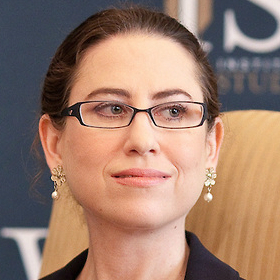War Studies Program
Learn the theory, practice, organization, and control of war and military forces.
Summer 2016
Washington, DC
This War Studies Advanced Program will introduce students to the Soviet Union, American grand strategic thinking in the early Cold War, and U.S. and Soviet nuclear thought. It will consider the challenge Americans faced defining and understanding the Soviet threat. It will also explore the Soviet view of the Cold War, the challenges facing Moscow, and Soviet approaches to meeting those challenges. It will highlight the way wildly divergent experiences in World War II, as well as extreme differences in ideology, shaped each side’s perception of the other and created mutually-incompatible approaches to the conflict. It will also explore the development and evolution of nuclear war theory on both sides, emphasizing the very different conclusions drawn about the nature and acceptability of nuclear war by systems guided by such opposing ideologies and experiences. It will end by considering how to apply lessons drawn from the Cold War to the challenges emanating from Russia today.
War Studies Advanced Programs are open only to alumni of the basic War Studies course. These sessions are offered in the winter and summer, and focus either on a national security challenge or on a historical conflict. Learn more about the War Studies Program.
Image courtesy | Ronald Reagan Presidential Library
Fred Kagan on war and statesmanship

LTG James M. Dubik (U.S. Army, Ret.) is a Senior Fellow at the Institute for the Study of War and a Professor at Georgetown University’s Security Studies Program. General Dubik has extensive operational experience in Iraq, Afghanistan, Japan, Korea, Thailand, Bosnia, Haiti, Panama, and in many NATO countries.

LTG James M. Dubik (U.S. Army, Ret.) is a Senior Fellow at the Institute for the Study of War and a Professor at Georgetown University’s Security Studies Program. General Dubik has extensive operational experience in Iraq, Afghanistan, Japan, Korea, Thailand, Bosnia, Haiti, Panama, Honduras, and in many NATO countries.
His last job on active duty was as Commanding General of the Multinational Security Transition Command-Iraq (MNSTC-I) and the NATO Training Mission-Iraq during the Surge of 2007–2008. He is a member of the U.S. Army Ranger Hall of Fame and a distinguished member of the U.S. Army 75th Ranger Regiment.
General Dubik taught Philosophy at West Point and Campaign Theory and Practice at the U.S. Army School of Advanced Military Studies, Fort Leavenworth, Kansas. He has completed an MIT fellowship program for national security studies as well as executive programs in national security at Harvard’s JFK School of Government and Syracuse University’s Maxwell School of Citizenship and Public Affairs. He is the author, most recently, of Just War Reconsidered: Strategy, Ethics, and Theory.
He holds a Bachelor’s Degree in Philosophy from Gannon University, Erie, Pennsylvania; a Masters in Military Arts and Sciences from the Army Command and General Staff College, Fort Leavenworth, Kansas; and a Ph.D. in Philosophy from the Johns Hopkins University.

Frederick W. Kagan is a Senior Instructor with the Hertog War Studies Program at the Institute for the Study of War. The author of the 2007 report “Choosing Victory: A Plan for Success in Iraq,” he is one of the intellectual architects of the successful “surge” strategy in Iraq. He is the director of AEI’s Critical Threats Project.

Frederick W. Kagan is a Senior Instructor with the Hertog War Studies Program at the Institute for the Study of War. The author of the 2007 report “Choosing Victory: A Plan for Success in Iraq,” he is one of the intellectual architects of the successful “surge” strategy in Iraq. He is the Robert H. Malott Chair and Director of the Critical Threats Project at the American Enterprise Institute (AEI).
In 2009, he served in Kabul, Afghanistan, as part of General Stanley McChrystal’s strategic assessment team, and he returned to Afghanistan in 2010, 2011, and 2012 to conduct research for Generals David Petraeus and John Allen. In July 2011, Chairman of the Joint Chiefs of Staff Admiral Mike Mullen awarded him the Distinguished Public Service Award, the highest honor the Chairman can present to civilians who do not work for the Department of Defense, for his volunteer service in Afghanistan.
He is coauthor of the report Defining Success in Afghanistan (AEI and the Institute for the Study of War, 2010) and author of the series of reports Choosing Victory (AEI), which recommended and monitored the US military surge in Iraq. His most recent book is Lessons for a Long War: How America Can Win on New Battlefields (AEI Press, 2010, with Thomas Donnelly). Previously an associate professor of military history at West Point, Dr. Kagan is a contributing editor at the Weekly Standard and has written for Foreign Affairs, the Wall Street Journal, the Washington Post, the Los Angeles Times, and other periodicals.
He holds a Ph.D. from Yale University in Russian and Soviet military history.

Kimberly Kagan is a Senior Instructor with the Hertog War Studies Program and founder and president of the Institute for the Study of War. She is a military historian who has taught at the U.S. Military Academy at West Point, Yale, Georgetown, and American University.

Kimberly Kagan is a Senior Instructor with the Hertog War Studies Program and founder and president of the Institute for the Study of War. She is a military historian who has taught at the U.S. Military Academy at West Point, Yale, Georgetown, and American University.
Dr. Kagan served in Kabul for seventeen months from 2010 to 2012 working for commanders of the International Security Assistance Force, General David H. Petraeus and subsequently General John Allen. Admiral Mike Mullen, as Chairman of the Joint Chiefs of Staff, recognized Dr. Kagan for this deployment as a volunteer with the Distinguished Public Service Award, the highest honor the Chairman can present to civilians who do not work for the Department of Defense.
Dr. Kagan previously served as a member of General Stanley McChrystal’s strategic assessment team, comprised of civilian experts, during his campaign review in June and July 2009. She conducted many regular battlefield circulations of Iraq between May 2007 and April 2010 while General Petraeus and General Raymond T. Odierno served as the MNF-I Commanding General.
Dr. Kagan held an Olin Postdoctoral Fellowship in Military History at Yale International Security Studies in 2004 to 2005 and was a National Security Fellow at Harvard’s Olin Institute for Strategic Studies in 2002 to 2003. She received her B.A. in Classical Civilization and her Ph.D. in History from Yale University.
This lesson will focus on two major themes. First we will consider two opposing definitions of the Soviet threat that competed within the U.S. government in the first decade of the Cold War—George Kennan’s and that embodied in NSC-68, drafted under the leadership of Paul Nitze. We will then explore the two conflicting grand strategies proposed by Kennan and NSC-68 and consider why Nitze’s ultimately prevailed. We will move from this discussion to an assessment of the desirability of reconsidering Kennan’s rejected grand strategic approach in the current national security environment.
Readings:
This lesson will begin by examining the nature of the Soviet state from the Soviet perspective. We will look at the origins and evolution of the Soviet Union, the Stalin period, and Soviet experiences during the Second World War (the Great Patriotic War) to understand the very different perspective Soviet leaders might have had on world affairs from their American counterparts. We will consider how the Cold War appeared to the Soviets from its earliest days. We will examine, briefly, Soviet ideology as it relates to war and international relations.
Readings:
This lesson will explore the origins and evolution of American thinking about atomic and nuclear war. We will discuss the difference between atomic and thermonuclear weapons and the implications of that difference for thinking about nuclear war. We will then consider the ways in which American nuclear theorists wrestled with the problem of thinking about how to wage nuclear war and, ultimately, about whether that question was even meaningful.
Readings:
This lesson will consider the Soviet approach to thinking about atomic and nuclear war. It will contrast Soviet thought not only with American theory, but also with the understanding American theorists had about Soviet nuclear thinking. We will discuss the dangers inherent in assuming common rationality with an opponent and how to identify and mitigate those dangers. We will also consider the implications for deterrence of varying assessments of the feasibility of waging nuclear war.
Readings:
We will end this course by examining current American and Russian doctrine and policy regarding nuclear weapons and nuclear war. To what extent have Washington and Moscow converged on a common assessment of the feasibility of waging nuclear war or of waging limited nuclear war? How well does American policy appear to understand Russian theories, policies, and doctrines? How can we apply Cold War theories to the modern world in which multiple states maintain nuclear arsenals but are no longer aligned neatly into two camps? Do they apply at all?
Readings:
Vance Serchuk
Vance Serchuk is Executive Director of the KKR Global Institute and an Adjunct Senior Fellow at the Center for a New American Security. Prior to joining KKR, Mr. Serchuk served for six years as the senior national security advisor to Senator Joseph Lieberman (I-Connecticut).

Vance Serchuk
Vance Serchuk is Executive Director of the KKR Global Institute and an Adjunct Senior Fellow at the Center for a New American Security. Prior to joining KKR, Mr. Serchuk served for six years as the senior national security advisor to Senator Joseph Lieberman (I-Connecticut).

Eric S. Edelman
Ambassador Eric S. Edelman is Counselor at the Center for Strategic and Budgetary Assessments. He retired as a career minister from the U.S. Foreign Service on May 1, 2009. He has served in senior positions at the Departments of State and Defense as well as the White House, where he led organizations providing analysis, strategy, policy development, security services, trade advocacy, public outreach, citizen services, and congressional relations.

Steven F. Hayward
Steven F. Hayward is a senior resident scholar at the Institute of Governmental Studies at UC Berkeley, Senior Fellow of the Claremont Institute, and a visiting lecturer at Boalt Hall Law School. Hayward is the author of a two-volume narrative history of Ronald Reagan and his effect on American political life, The Age of Reagan: The Fall of the Old Liberal Order, 1964-1980, and The Age of Reagan: The Conservative Counter-Revolution, 1980-1989.

Daniel Johnson
Daniel Johnson is an author, journalist, and founding editor of Standpoint, a monthly British cultural and political magazine. He is the author of White King and Red Queen: How the Cold War was Fought on the Chessboard.